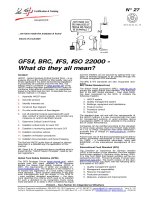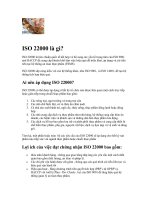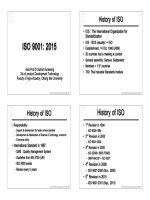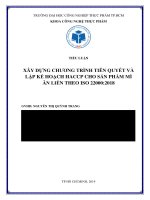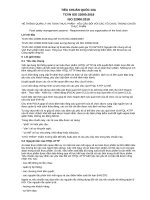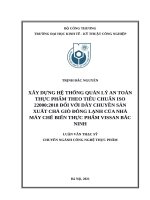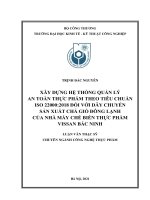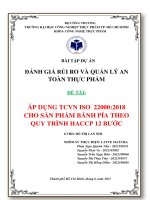NLU-03-ISO-22000-2018
Bạn đang xem bản rút gọn của tài liệu. Xem và tải ngay bản đầy đủ của tài liệu tại đây (3.91 MB, 16 trang )
1
2
• Problems in food supply chains
• Need for harmonisation
• No standard for all stakeholders
in the food supply chain
• Integration Food Safety in
management systems (ISO9001, ISO-14001)
Requirements for
Food Safety Management System
(FSMS)
ระบบการจัดการความปลอดภัยอาหาร
Asst.Prof.Dr.Suthat Surawang - QA-NLU-2018-ISO22000
Asst.Prof.Dr.Suthat Surawang - QA-NLU-2018-ISO22000
3
• Sudan Dyes Contamination in UK 2003-2005
• Sudan dyes are red dyes that are used for colouring:
Solvents, Oils Waxes, Petrol, and Shoe and Floor polishes.
• Academic debate is divided – but some suggests that Sudan
Dyes are Carcinogenic
• Sudan dyes are not allowed to be added to food in the UK
and the rest of the EU.
• Financial Loss (£ 100 Million)
4
• UK: BRC (British Retailer Consortium)
• German/France : IFS (International
Food Standard)
• Australia : SQF (Safe Quality Food)
• USA : HACCP
• Netherlands : RVA (?)
– Loss of Public Confidence
– Loss of Potential Future Business
– Loss of Reputation for Good Companies
• Final Cost is Unknown
Asst.Prof.Dr.Suthat Surawang - QA-NLU-2018-ISO22000
Asst.Prof.Dr.Suthat Surawang - QA-NLU-2018-ISO22000
5
Communicating within the food Supply Chain
Asst.Prof.Dr.Suthat Surawang - QA-NLU-2018-ISO22000
WHY ISO-22000?
Asst.Prof.Dr.Suthat Surawang - QA-NLU-2018-ISO22000
7
• No standard for all stakeholders in the food
supply chain
• HACCP (Codex) do not content of management
system elements like ISO 9001
• From Farm to Table
• From Farm to Fork
• Primary production to Final consumption
8
pesticides
Food Supply
fertilisers
Chains
animal feed
packaging
chemical
processing
utilities
machines
breeding
fishing
farming
fish
dairy
growing
slaughtering
deboning
chemical
products
meat
fruit /
vegetables /
grains
services
transport /
storage
HACCP
Asst.Prof.Dr.Suthat Surawang - QA-NLU-2018-ISO22000
6
chemical
products
fresh /
frozen
meat
fresh /
frozen fish
short/long
shelf life
fresh dairy
fresh/fro zen fruit/
vegetables
processed food
distribution / sales / consuming
Asst.Prof.Dr.Suthat Surawang - QA-NLU-2018-ISO22000
9
Characteristics of ISO-22000
•
•
•
•
•
•
•
Food%Safety%Management%System%standard%
Scope:%all%suppliers%of%the%food%supply%chain
Supply%chain%approach
Clear%description%/%requirements%for%hazard%analysis
Requirements%for%communication
Clear%requirements%for%validation,%verification,%change%control
Relevant%hazards:%control%by%CCP’s%and%Operational%PRP’s%
(OPRP)
• No%list%of%specific%good%practices%included
• Additional requirements clients like retail
10
• Key elements to ensure food safety along
the food chain to final consumption
• Interactive communication
• System management
• Pre-requisite programmes
• HACCP principle
– Part of certification scheme or technical specification
– Assessed by CB or client
Asst.Prof.Dr.Suthat Surawang - QA-NLU-2018-ISO22000
Asst.Prof.Dr.Suthat Surawang - QA-NLU-2018-ISO22000
11
elements of
ISO-9001:2008
12
• Codex'Alimentarius:'
Verification
HACCP'System'and'
Guidelines'for'its'
application
Management%
•GAP,GMP,GDP,'GRP’sSystem%elements
•Codex'Alimentarius:'
General'Principles'of'
Food
Hygiene'(CAC/RCP'1)
HACCP%principles%
(Codex%Alimentarius)
Pre-requisite program(s)
Asst.Prof.Dr.Suthat Surawang - QA-NLU-2018-ISO22000
Monitoring &
Corrective
actions
Improvement
-Planning &
Validation
realization of
Hazard
of
safe products Identification
Control
-Risk
-requirements
measures
assesment
PRP’s
Implementation
CCP’s
operational
PRP’s
Control
measures
Asst.Prof.Dr.Suthat Surawang - QA-NLU-2018-ISO22000
13
14
1.
2.
3.
4.
5.
6.
7.
8.
ISO%22000
The%standard%&%its%
content
มอก.-22000-2548
(ประกาศกระทรวงฯ
ฉ.3441 พศ. 2548)
Scope
Normative%references
Terms%and%definitions
Food%safety%management%system%(FSMS)
Management%responsibility%
Resource%management%
Planning%and%realization%of%safe%products
Validation,%verification,%and%improvement%of%FSMS
Asst.Prof.Dr.Suthat Surawang - QA-NLU-2018-ISO22000
Asst.Prof.Dr.Suthat Surawang - QA-NLU-2018-ISO22000
15
1.Scope
This International Standard specifies requirements to
enable an organization
• to plan, implement, operate, maintain and update a
food safety management system
• to demonstrate compliance with applicable statutory
and regulatory food safety requirements
• to evaluate and assess customer requirements in order
to enhance customer satisfaction,
• to effectively communicate food safety issues
• to ensure that the organization conforms to its stated
food safety policy
• to seek certification or registration of its food safety
management system
Asst.Prof.Dr.Suthat Surawang - QA-NLU-2018-ISO22000
16
1.Scope
2.Normative reference
- ISO 9000:2000, Quality Management Systems- Fundamental and Vocabulary
3. Terms and definitions
3.1%Food%safety
3.10%Critical%control%point%(CCP)
3.2%Food%chain
3.11%Critical%limit%(CL)
3.3%Food%safety%hazard
3.12 Monitoring
3.4%Food%safety%policy
3.13%Correction
3.5%End%product
3.14%Corrective%action
3.6%Flow%diagram
3.15%Validation
3.7%Control%measure
3.16%Verification
3.8%%Prerequisite%programme (PRP)
3.17%Updating
3.9%%Operational%prerequisite%
programme (oPRP)
Asst.Prof.Dr.Suthat Surawang - QA-NLU-2018-ISO22000
17
4. Food safety management system
4. Food safety management system
4.1 General requirements
- communication
- outsources*
4.2 Documentation requirements
4.2.1 General
- scope, policy, aim, documented procedures*
*4.2.2 Document control
*4.2.3 Record control
4.2 Documentation requirements
4.2.1 General
- food safety policy and related objectives
- documented procedures and record
*4.2.2 Document control
*4.2.3 Record control
- External documents e.g.. Specification, Recipes,
Artwork, for packaging, Legislation, Code of practices,
Equipment manuals, HACCP plan and documents
- Documents e.g. paper, electronic formats
* Where an organization chooses to outsource any process that
may affect end product conformity, the organization shall ensure
control over such processes. Control of such outsourced processes
shall be identified and documented within the food safety
management system.
* Shall be Documented procedures (1, 2)
18
Asst.Prof.Dr.Suthat Surawang - QA-NLU-2018-ISO22000
Asst.Prof.Dr.Suthat Surawang - QA-NLU-2018-ISO22000
19
4. Food safety management system
4.2.2 Document control
A documented procedure shall be established to define the controls needed
a) to approve documents for adequacy prior to issue,
b) to review and update documents as necessary, and re-approve
documents,
c) to ensure that changes and the current revision status are identified,
d) to ensure that relevant versions of documents are available at points
of use,
e) to ensure that documents remain legible and readily identifiable,
f) to ensure that relevant documents of external origin are identified and
their distribution controlled, and
g) to prevent the unintended use of obsolete documents, and to ensure
that they are suitably identified
Asst.Prof.Dr.Suthat Surawang - QA-NLU-2018-ISO22000
20
Record control
Complete
records
No liquid paper
Cross mark
with signature
Record keeping
Storage
Destroy
Asst.Prof.Dr.Suthat Surawang - QA-NLU-2018-ISO22000
21
5. Management responsibility
5.1 Management commitment
5.2 Food safety policy
5.3 Food safety management system planning
5.4 Responsibility and authority
5.5 Food safety team leader
5.6 Communication
5.6.1 External communication
5.6.2 Internal communication
5.7 Emergency preparedness and response*
5.8 Management review
5.8.1 General
5.8.2 Review input
5.8.3 Review output
* shall be procedure
22
Quality Policy
It is policy of this company to
provide its customer high
quality products. 100% ontime delivery and over
improving levels of satisfaction.
ABC Corp. is dedicated to the
continual improvement of its
products, services and the
company itself, through
process control, employee
empowerment and
management commitment.
Asst.Prof.Dr.Suthat Surawang - QA-NLU-2018-ISO22000
High quality products
• Quality index data
100% on-time delivery
• Delivery history data
Customer satisfaction
• Customer complaint data
Continual improvement
• Internal audit report
Asst.Prof.Dr.Suthat Surawang - QA-NLU-2018-ISO22000
23
Intention
Unintentional
Sabotage / Terrorism
(Food defense)
Natural disaster ;
Flood, Hurricane, Tsunami,
earthquake
Strike / Mob
Pandemic / Outbreak;
Bird flu, Influenza 2009
24
6.Resource management
6.1 Provision of resources
6.2 Human resources
6.2.1 General
6.2.2 Competence, awareness and training
6.3 Infrastructure
6.4 Work environment
Disruption ; Power cut, no
water, no steam, ammonia
leak, IT failure
Asst.Prof.Dr.Suthat Surawang - QA-NLU-2018-ISO22000
Asst.Prof.Dr.Suthat Surawang - QA-NLU-2018-ISO22000
25
7.Planning and realization of safe products
26
7.2.2 The PRPs shall
7.1 General
7.2 Prerequisite programmes (PRPs)
7.3 Preliminary steps to enable hazard analysis
7.4 Hazard analysis
7.5 Establishing operational PRPs (OPRPs)
7.6 Establishing the HACCP plan
7.7 Updating of preliminary information and documents
specifying the PRP(s) and the HACCP plan
7.8 Verification planning
7.9 Traceability system
7.10 Control of non-conformity
a) be appropriate to the organizational needs with regard to
food safety,
b) be appropriate to the size and type of the operation and
the nature of the products being manufactured and/or
handled,
c) be implemented across the entire production system,
either as programmes applicable in general or as
programmes applicable to a particular product or
operational line, and
d) be approved by the food safety team.
*องค์กรต้องชี้แจงข้อกฎหมายและข้อกำหนดข้อบังคับที่เกี่ยวข้อง
Asst.Prof.Dr.Suthat Surawang - QA-NLU-2018-ISO22000
Asst.Prof.Dr.Suthat Surawang - QA-NLU-2018-ISO22000
27
7.2.3 The PRPs
a) construction and lay-out of buildings and associated utilities;
b) lay-out of premises, including workspace and employee facilities;
c) supplies of air, water, energy and other utilities;
d) supporting services, including waste and sewage disposal;
e) the suitability of equipment and its accessibility for cleaning,
maintenance and preventative maintenance;
f) management of purchased materials (e.g. raw materials, ingredients,
chemicals and packaging), supplies (e.g. water, air, steam and ice),
disposals (e.g. waste and sewage) and handling of products (e.g.
storage and transportation);
g) measures for the prevention of cross contamination;
h) cleaning and sanitizing;
i) pest control;
j) personnel hygiene;
k) other aspects as appropriate.
Asst.Prof.Dr.Suthat Surawang - QA-NLU-2018-ISO22000
28
7.3 Preliminary steps to enable hazard analysis
7.3.1 General
7.3.2 Food safety team
7.3.3 Product characteristics
7.3.3.1 R/Ms*, ingredients and product contact materials
7.3.3.2 Characteristics of end products
7.3.4 Intended use
7.3.5 Flow diagrams, process steps and control measures
7.3.5.1 Flow diagrams (rework, reprocess, input/output)
7.3.5.2 Description of process steps and control measures
*origins
Asst.Prof.Dr.Suthat Surawang - QA-NLU-2018-ISO22000
29
7.4 Hazard analysis
7.4.1 General
7.4.2 Hazard identification and determination of Ac levels
7.4.3 Hazard assessment
7.4.4 Selection and assessment of control measures*
(a - g)
7.5 Establishing operational PRPs (OPRPs)
7.6 Establishing the HACCP plan
* 7.4.4มีทั้งหมด7 ข้อ (a-g) ที่ใช้เป็นเกณฑ์ตัดสินใจว่าเป็น OPRP หรือ CCP
30
7.4.4 Logical approach
a) its effect on identified food safety hazards relative to the
strictness applied;
b) its feasibility for monitoring;
c) its place within the system relative to other control
measures;
d) the likelihood of failure in the functioning of a control
measure or significant processing variability;
e) the severity of the consequence(s) in the case of failure
in its functioning;
f) whether the control measure is specifically established
and applied to eliminate or significantly reduce the level
of hazard(s);
g) synergistic effects
Asst.Prof.Dr.Suthat Surawang - QA-NLU-2018-ISO22000
Asst.Prof.Dr.Suthat Surawang - QA-NLU-2018-ISO22000
31
7.5 The OPRPs shall be documented and shall include
a) food safety hazard(s) to be controlled by the programme
(see 7.4.4);
b) control measure(s) (see 7.4.4);
c) monitoring procedures that demonstrate that the
operational PRPs are implemented;
d) corrections and corrective actions to be taken if
monitoring shows that the operational PRPs are not in
control (see 7.10.1 and 7.10.2, respectively);
e) responsibilities and authorities;
f) record(s) of monitoring.
Asst.Prof.Dr.Suthat Surawang - QA-NLU-2018-ISO22000
32
7.6 Establishing the HACCP plan
*7.6.1 HACCP plan
*7.6.2 Identification of CCPs
*7.6.3 Determination of critical limits for CCPs
*7.6.4 System for the monitoring of CCPs
*7.6.5 Action when monitoring results exceed CLs
7.7 Updating of preliminary information and documents
specifying the PRP(s) and the HACCP plan
7.8 Verification planning
7.9 Traceability system
7.10 Control of non-conformity
* Shall be Documented procedures (3)
Asst.Prof.Dr.Suthat Surawang - QA-NLU-2018-ISO22000
33
7.6.1 HACCP plan
34
7.10 Control of non-conformity*
*7.10.1 Corrections
*7.10.2 Corrective actions
7.10.3 handling of potentially unsafe products
a) food safety hazard(s) to be controlled at the CCP (see
7.4.4);
b) control measure(s) (see 7.4.4);
c) critical limit(s) (see 7.6.3);
d) monitoring procedure(s) (see 7.6.4);
e) corrections and corrective action (s) to be taken if critical
limits are exceeded (see 7.6.5);
e) responsibilities and authorities;
f) record(s) of monitoring.
7.10.3.1 General
7.10.3.2 Evaluation for release
7.10.3.3 Disposition of nonconforming products
*7.10.4 Withdrawals
* Process specification / Product specification
* shall be Documented Procedure (4,5,6)
Asst.Prof.Dr.Suthat Surawang - QA-NLU-2018-ISO22000
Asst.Prof.Dr.Suthat Surawang - QA-NLU-2018-ISO22000
35
36
8.Validation, verification and improvement of FSMS
8.1 General
8.2 Validation of control measure combinations
8.3 Control of monitoring and measuring
8.4 Food safety management system verification
*8.4.1 Internal audit
8.4.2 Evaluation of individual verification results
8.4.3 Analysis of results of verification activities
8.5 Improvement
8.5.1 Continual improvement
8.5.2 Updating the food safety management system
Update
(8.5.2)
Verification
(8.4.3)
Validation
(8.2)
* Shall be Documented procedures (7)
Asst.Prof.Dr.Suthat Surawang - QA-NLU-2018-ISO22000
Asst.Prof.Dr.Suthat Surawang - QA-NLU-2018-ISO22000
37
• The%Management%System “Stuff%”%%_ Clauses%1%– 6
• Pre_Requisite%Programmes%(PRP)%_ Clause%7.2
• HACCP%%%_ Clauses%7.3%– 7.7
Validation,'verification'
and'improvement''of'
FSMS'(8)
Customer
Management'
responsibility(5)
Requirements
Input
Planning'and'
realization'of'
safety'product'
(7)
Resource'
management'
(6)
Output
Customer
FSMS'(4)
38
•
•
•
•
Annex%A:%cross%reference%with%ISO_9001
Annex%B:%cross%reference%with%HACCP%principles
Annex%C:%examples%codes%of%practices%and%control%measures
Guideline:%guidance%on%the%use%of%the%standard%Normative%
references
Satisfaction
Asst.Prof.Dr.Suthat Surawang - QA-NLU-2018-ISO22000
Asst.Prof.Dr.Suthat Surawang - QA-NLU-2018-ISO22000
39
How'can'ISOR22000'help'the'food'industry?
• Improvement of assurance food safety in the
whole chain
• International harmonisation
• Prevention of overlap of standards / audits
• Reduction time and costs
• Improvement of quality of audits
• Independent assessments for conformity
statements and as tool for continuous
improvement
Asst.Prof.Dr.Suthat Surawang - QA-NLU-2018-ISO22000
40
ISO 9001 and ISO 22000
ISO'9001:2008
ISO'22000:2005
Quality%Management%System Food%Safety%Management%System
(FSMS)
(QMS)
Customer satisfactions
Consumer satisfactions (Food
(Quantity, Quality and Delivery) safety products along to Food
chain)
For all business
For food supply chain and food
manufacturer
(Industry, manufacturer,
service)
Asst.Prof.Dr.Suthat Surawang - QA-NLU-2018-ISO22000
41
42
3 methods for Control Measures
CCP
PRPs
•Basic%conditions%
and%activities
•PRPs%don’t%
need%validation%
but%their%
effectiveness%
shall%be%verified%
periodically
•GMP,%GHP,%
GDP,%GVP
Operational'
PRPs
•Control%measure
•Monitoring%
procedure
•Correction/correcti
ve%action%
•No%CL%(Target%
value)
HACCP'Plan'
&'its'CCP
OPRP
•Control%measures
•Monitoring%
procedure
•Correction/correcti
ve%action
•ISO22000-7.6
•CL
PRP
Basic hygiene, GMP, minimum
legal requirements
•ISO22000-7.5
•ISO22000%_ 7.2
Asst.Prof.Dr.Suthat Surawang - QA-NLU-2018-ISO22000
Asst.Prof.Dr.Suthat Surawang - QA-NLU-2018-ISO22000
43
• ISO-22000:2005, para 3.8 : PRP , prerequisite
programme
(food safety) basic conditions and activities that are
necessary to maintain a hygienic environment
throughout the food chain (3.2) suitable for the
production, handling and provision of safe end
products (3.5) and safe food for human consumption
NOTE The PRPs needed depend on the segment of the food
chain in which the organization operates and the type of
organization (see Annex C). Examples of equivalent terms are:
Good Agricultural Practice (GAP), Good Veterinarian Practice
(GVP), Good Manufacturing Practice (GMP), Good Hygienic
Practice (GHP), Good Production Practice (GPP),Good
Distribution Practice (GDP) and Good Trading Practice (GTP).
Asst.Prof.Dr.Suthat Surawang - QA-NLU-2018-ISO22000
44
• ISO-22000:2005, para 3.9: operational PRP (OPRP)
operational prerequisite programme
PRP (3.8) identified by the hazard analysis as
essential in order to control the likelihood of
introducing food safety hazards (3.3) to and/or the
contamination or proliferation of food safety hazards
in the product(s) or in the processing environment
• ISO22000:2005, para 3.10 CCP, critical control point
(food safety) step at which control can be applied
and is essential to prevent or eliminate a food safety
hazard (3.3) or reduce it to an acceptable level
Asst.Prof.Dr.Suthat Surawang - QA-NLU-2018-ISO22000
45
46
• 3 approaches for determination of OPRP and CCP
1. Risk Assessment (Severity & Occurance) of identified
hazards
severity
1 – 3 ! PRP
4 – 9 ! OPRP or CCP
2. Answer the question of 7.4.4 (a –g)
High
(ICU-death)
Medium
(Admit –ICU)
Low
(meet doctor)
7.4.4 Selection and assessment of control
measures
6
9
2
4
6
1
2
3
Low
(6-12 months)
Total score > 18 ! CCP
Total score < 18 ! OPRP
3. Using Decision tree (Q1-Q4) combined with 7 questions ( 7.4.4)
Y-Y or Y-N-Y-N ! CCP
Y-N-Y-Y or Y-N-N ! OPRP / PRP
Y-N-N ! PRP
Asst.Prof.Dr.Suthat Surawang - QA-NLU-2018-ISO22000
3
Medium
High
(1-6 months) (every month)
likelihood of Occurrence
1-3 control by PRP
4-9 control by OPRP / CCP
Asst.Prof.Dr.Suthat Surawang - QA-NLU-2018-ISO22000
47
a) its effect on identified food safety hazards relative to the strictness
applied;
b) its feasibility for monitoring (e.g. ability to be monitored in a timely
manner to enable immediate corrections);
c) its place within the system relative to other control measures;
d) the likelihood of failure in the functioning of a control measure or
significant processing variability;
e) the severity of the consequence(s) in the case of failure in its
functioning;
f) whether the control measure is specifically established and
applied to eliminate or significantly reduce the level of hazard(s);
g) synergistic effects (i.e. interaction that occurs between two or
more measures resulting in their combined effect being higher
than the sum of their individual effects).
Asst.Prof.Dr.Suthat Surawang - QA-NLU-2018-ISO22000
48
Example: 7.4.4 (a – g)
Control measure
a
b
c
d
e
f
g
Total
OPRP CCP
Control temperature of cold 3
storage tank
3
Pasteurization
2
1
2
1
3
2
14
✓
-
3
3
1
3
3
2
18
-
✓
< 18 = OPRP
> 18 = CCP
Asst.Prof.Dr.Suthat Surawang - QA-NLU-2018-ISO22000
Risk%likelihood%of%Occurrence*
Health risk assessment model
High
Sa
Mi
Ma
Cr
Medium
Sa
Mi
Ma
Ma
Low
Sa
Mi
Mi
Mi
Neg
Sa
Sa
Sa
Sa
Medium
High
Low
49
Q1 – Do control preventive measure(s) exist ?
Q2 – Is the step specifically designed to eliminate or
reduce the likely occurrence of the identified
Hazard to an acceptable level?
Q3 – Could contamination with identified hazard(s) occur
in excess of acceptable level or would these
increase to unacceptable levels?
Q4 – Will a subsequent step eliminate identified hazards
or reduce the likely occurrence of a hazard to
an acceptable level(s)?
Severity%of%Consequences
*inversely%proportional%to%the%degree%of%control
49
Sa%– Satisfactory%(negligible)
Mi%– Minor
Ma%– Major
Cr%– Critical
Asst.Prof.Dr.Suthat Surawang - QA-NLU2018-ISO22000
Modify'steps'in'the'
Process'or'Product
Start
Q1
N
Q1a
Decision Tree (HACCP)
50
Asst.Prof.Dr.Suthat Surawang - QA-NLU2018-ISO22000
51
Y
Q1
a+b
Y
N
Q2
Q3
51
Q4
52
Y
Q1a
N
Q2
+f
Stop*
N
N
Not'CCP
Stop*
Q3
d+e
CCP
Y
N
N
Y
N
CCP
Modify'steps'in'the'
Process'or'Product
Start
Y
Y
50
N
OPRP
Y
Y
N
*Proceed%to%the%next%step
Q1a%–Is%this%step%necessary%to%control%for%safety?
Asst.Prof.Dr.Suthat Surawang - QA-NLU2018-ISO22000
Q4
c+g
Y
*Proceed%to%the%next%step
Q1a%–?
52
Asst.Prof.Dr.Suthat Surawang - QA-NLU2018-ISO22000
Sample: Determination of CCP and OPRP
Steps
Hazards
Receiving
B: bacteria
C: Antibiotic
P: stone
Pasteurization B: bacteria
C: Antibiotic
P: 53
53
Q1 Q2 Q3 Q4 CCP /
oPRP
✓ ✗ ✓ ✓ oPRP
✓ ✓ - - CCP
✓
✓
-
✗
✓
-
✗
-
-
CCP
-
54
• What are the differences between PRP and
OPRP and HACCP-plan
Purposes'of'the'control'measure
PRP
OPRP
CCP
Maintenance%the%basic( generic)%
hygienic%condition%and%activities
Yes
No
No
Controlling%hazards%identified%by%hazard%
analysis%and%need%to%be%controlled
No
Yes
Yes
Validation%is%required
No
Yes
Yes
Monitoring%and%record%are%required
No
Yes
Yes
Correction%/%corrective%action
N/A
out%of%
control
>CL
Control%measure
Asst.Prof.Dr.Suthat Surawang - QA-NLU2018-ISO22000
Asst.Prof.Dr.Suthat Surawang - QA-NLU-2018-ISO22000
55
• Correction Action to eliminate a detected
nonconformity
• Corrective action
– Action to eliminate the cause of a detected
nonconformity or other undesirable situation
– Prevent recurrence
• Preventive action
– Prevent occurrence
Asst.Prof.Dr.Suthat Surawang - QA-NLU-2018-ISO22000
General% Likelihood% Preventive
control
control
control
Withdrawal & Recall
56
• Withdrawal
– any measure aimed at preventing the distribution, display
and offer of a product dangerous to the consumer.
– any measures aimed at achieving the return of out-of
specification or unfit products from customers, but not
from final consumers
• Recall
– any measure aimed at achieving the return of a dangerous
product that has already been supplied or made available
to consumers by the producer or distributor.
– any measures aimed at achieving the return of an unfit
product from customers and final consumer
Asst.Prof.Dr.Suthat Surawang - QA-NLU-2018-ISO22000
57
Verification & Validation
Are$we$doing$the$right$things?
Validation
Literature
Our%plans
Monitoring Verification & Validation
Monitoring
• During%operation
• Documenting%that%control%measure%functions%
as%intended
Verification
• After%operation
• Documenting%that%monitoring%work
• Degree%of%intended%control%has%been%delivered
Validation
• Prior%to%operation
• Documenting%that%control%measure%is%capable%of%
delivering%the%need%effects
58
Are$we$doing$things$right$?
Verification
Our%plans
Our%Activities
Asst.Prof.Dr.Suthat Surawang - QA-NLU-2018-ISO22000
Asst.Prof.Dr.Suthat Surawang - QA-NLU-2018-ISO22000
59
60
• Documentation for ISO22000:2005 (shall in clauses)
Total
Documented
Procedure
Document
Record
4. Food Safety Management System
14
2
4
0
5. Management Responsibility
26
1*
1
2
6. Resource Management
7
0
0
2
7. Planning and realization of safe products
107
4
8
20
8. Validation, verification and improvement of
FSMS
39
1
0
6
Total
193
8
13
30
Shall in clauses
Asst.Prof.Dr.Suthat Surawang - QA-NLU-2018-ISO22000
* procedure
Asst.Prof.Dr.Suthat Surawang - QA-NLU-2018-ISO22000
61
• ISO22000:2005 (document review guide)
• ISO22000:2005 (document review guide)
• Documented Procedure
•
•
•
•
•
•
•
•
•
•
62
• Documented Procedure
Document%Control
Food%Safety%Records
Management%Responsibility
Competence,%Awareness,%and%Training
Job%Descriptions
Prerequisite%Programs
Hazard%Analysis%Preparation
Hazard%Analysis
HACCP%Plan%Management
Purchasing
•
•
•
•
•
•
•
•
•
•
•
Asst.Prof.Dr.Suthat Surawang - QA-NLU-2018-ISO22000
Supplier%Evaluation
Receiving%and%Inspection
Manufacturing
Identification,%Labeling,%and%Traceability
Control%of%Monitoring%and%Measuring
Control%of%Nonconforming%Product
Internal%Audit%and%System%Validation
Corrective%Action
Continuous%Improvement
Product%Recall
Emergency%Preparedness%and%Response
Asst.Prof.Dr.Suthat Surawang - QA-NLU-2018-ISO22000

